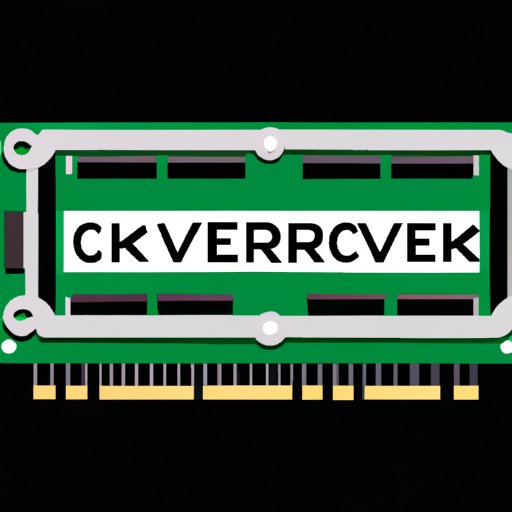
I. Introduction
If you’re a gamer, a video editor, or any other kind of power user, you know that your RAM is one of the most important components of your PC. But did you know that you can actually overclock your RAM to get even better performance? In this article, we’ll explore the basics of overclocking RAM, provide a detailed step-by-step guide, and discuss the benefits, risks, and common mistakes you should be aware of. Whether you’re a beginner or an experienced overclocker, you’ll find everything you need to know right here.
II. Overclocking Basics
Overclocking is the process of increasing the clock speed of a component in your PC, such as your processor or your RAM, in order to get better performance. Overclocking your RAM can help reduce latency and improve overall system performance, especially when running memory-intensive tasks like gaming or video editing.
There are two main methods for overclocking RAM: through your BIOS settings or by using software utilities. BIOS overclocking requires you to enter your computer’s BIOS settings and manually adjust your RAM’s clock speed and timings. Software utilities, on the other hand, allow you to change your RAM’s clock speed and timings from within Windows, without having to reboot into the BIOS.
For beginners, we recommend starting with software utilities like MSI Afterburner, which provides a user-friendly interface and allows you to easily adjust your RAM’s clock speed and timings. Once you’re comfortable with the process, you can move on to BIOS overclocking, which provides even more control and fine-tuning options.
III. Step-by-Step Guide
Before you start overclocking your RAM, you’ll need to make sure you have the right tools and software. Here’s what you’ll need:
- A PC with RAM that supports overclocking
- MSI Afterburner or another overclocking utility
- A stress-testing program like Prime95 or AIDA64
- A temperature monitoring program like HWMonitor or CoreTemp
Once you have everything you need, follow these steps:
- Open your overclocking utility and adjust your RAM’s clock speed and timings. We recommend starting with a small increase, such as 100MHz, and testing your system stability before making further adjustments. Make sure you don’t exceed the maximum clock speed recommended by your RAM’s manufacturer.
- Save your settings and restart your PC.
- Run your stress-testing program for at least an hour to make sure your system is stable. Keep an eye on your system temperatures using your temperature monitoring program.
- If your system passes the stress test, you can repeat the process with further clock speed adjustments. If your system becomes unstable or crashes during the stress test, you’ll need to reduce your clock speed or adjust your timings to try to achieve stability.
It’s important to note that overclocking can cause your system to become unstable and even damage your hardware if you push it too far. Be sure to follow the recommended guidelines for your RAM and keep a close eye on your system temperatures to avoid overheating.
IV. Benefits of Overclocking RAM
So, what kind of performance improvements can you expect from overclocking your RAM? In general, faster RAM clock speeds can lead to lower latency and better overall system performance. This can be especially beneficial for tasks like gaming, where higher frame rates and smoother gameplay can make all the difference.
For example, if you’re struggling to run a certain game at a playable frame rate, overclocking your RAM might be just what you need to push your system over the edge. Similarly, if you’re working with large files in a program like Adobe Photoshop or Premiere Pro, overclocking your RAM can help speed up your workflow and reduce rendering times.
V. Common Mistakes to Avoid
While overclocking your RAM can be a great way to boost your PC’s performance, there are some common mistakes you should be aware of. Here are a few things to keep in mind:
- Don’t exceed your RAM’s recommended maximum clock speed.
- Make sure your PC is properly cooled to avoid overheating.
- Don’t push your hardware too hard – a small overclock is usually better than a risky one.
- Be sure to test your system stability before making further adjustments.
VI. Advanced Tips and Tricks
If you’re an experienced overclocker and want to get the most out of your RAM overclock, there are a few advanced tips and tricks you can try:
- Manually adjust your RAM’s timings to fine-tune your performance.
- Run a memory stress-test program like MemTest86 to check your RAM’s stability.
- Try different RAM configurations, such as dual-channel versus quad-channel, to see what works best for your system.
VII. Risks and Downsides
It’s important to be aware of the potential risks and downsides of overclocking your RAM. Pushing your hardware too hard can cause instability, crashes, and even hardware damage. Additionally, overclocking can reduce the lifespan of your hardware and may affect your system’s stability in the long run.
To minimize these risks, be sure to follow your RAM’s recommended maximum clock speed and keep a close eye on your system temperatures. You should also avoid pushing your hardware too hard and always test your system stability before making further adjustments.
VIII. Conclusion
Overclocking your RAM can be a great way to boost your PC’s performance and get better results from memory-intensive tasks like gaming and video editing. However, it’s important to be aware of the potential risks and downsides, and to always follow your RAM’s recommended guidelines. With the right tools and software, and a little bit of patience, you can achieve a stable and effective RAM overclock that will take your PC to the next level.




